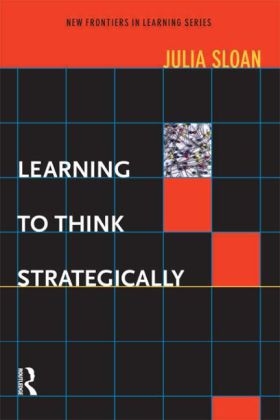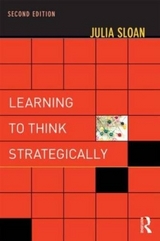
Learning to Think Strategically
Butterworth-Heinemann Ltd (Verlag)
978-0-7506-7879-7 (ISBN)
- Titel erscheint in neuer Auflage
- Artikel merken
In Learning to Think Strategically, author Julia Sloan presents a previously unexamined account of the relationship between strategic thinking and the learning process involved — taking learning from the academic to the everyday. This book is an original primer on how successful strategists learn to think strategically. This authoritative book traces the history of strategy, differentiates strategic thinking from planning, describes the influence of culture, streamlines the roles of rationality and intuition, and identifies five key attributes for learning to think strategically. Learning to Think Strategically asserts that learning is the critical link to strategic thinking. Learning is a "conversion tool" that can transform thinking strategically into a sustainable competitive advantage.
Preface
Acknowledgements
Introduction
PART I: HOW DID WE GET TO THIS POINT?
Back to the Future: A Historical Overview of Strategy
Chronology of Strategy
Ancient Greek Concept of Strategy
20th Century Corporate Strategy
Strategy and the Academy
Strategy and Consultancies
Shift in Corporate Strategy Role
Contemporary Competing Views of Strategy: Two Sides Face Off
Technical Rational Influence
Emergent Theory Influence
Comparative Discussion
Complexity Theory
Chaos Theory
Strategic Planning and Strategic Thinking: Two Sides of the Coin
Implications of Strategic History for Strategic Learning
Realignment of Strategy Approaches
PART II: HOW DO WE LEARN TO THINK STRATEGICALLY?
Formal Learning Takes a Backseat: It’s All About Informal Learning
Informal and Formal Learning Defined
Informal Learning
Incidental and Intentional Learning
Formal Learning Refuted
Context and Transfer as Factors in the Strategic Thinking Process
PART III: WHAT DOES LEARNING TO THINK STRATEGICALLY
LOOK LIKE?
A Murky but Miraculous Process: Three-Stage Model of Strategic Learning
Preparation Stage
Affective Component
Cognitive Component
Experience Stage
Current Experience
Prior Successful Life Experience
Application of Prior Experience to New Situations
Role of Reflection in the Three-Stage Informal Learning Process
Reevaluation Stage
PART IV: WHAT KIND OF LEARNING IS REQUIRED TO THINK STRATEGICALLY?
It’s Your Choice: The Surf and Dive Domains of Learning
Overview of Learning Domains Used for Strategic Thinking
Data, Information, and Knowledge
Three Predecessors to the Surf and Dive Learning Domains
The Surf and Dive Learning Domains
The Surf Doman
The Dive Domain
Transformative Learning
PART V: HOW CAN WE TALK ABOUT ALL THIS?
Dialogue: An Essential Part of Learning to Think Strategically
The Role of Dialogue in the Strategic Thinking Process
Comparison of Dialogue, Discussion, and Debate
Three Factors of a Good Strategic Thinking Dialogue
The Role of Inquiry in Critical Dialogue
Inquiry Supports Good Strategy Dialogue
Learning to Dialogue
PART VI: WHY DO WE LEARN STRATEGIC THINKING
THIS WAY? 129
We Just “Know”: Intuition as an Outgrowth of Experience
Intuition as a Must-Have for Learning to Think Strategically
Know-How: Our Tacit Knowledge
Framing
Pattern Recognition
Noticing Red Flags
Shattering Frames
Critical Reflection as a Tool for Shattering
Challenging Through Reflection in Action and Reflection on Action
The Element of Surprise
Pseudo Frame Change
Content Reflection, Process Reflection, and Premise Reflection
Reframing
Expertise and Experience: The Double-Edged Sword of Intuition
PART VII: WHAT ABOUT THE NUMBERS?
Strange Bedfellows: Intuition and Analysis as Partners in the Strategic Learning Process
The Roles of Analysis and Intuition in Strategic Decision Making
Intuition as a Check on Analysis
Analysis as a Check on Intuition
Decision-Making Approaches to Strategic Thinking
Traditional Strategic Decision Making
Integrated Strategic Decision Making
Coordinating Intuition and Analysis to Facilitate Strategic Thinking
PART VIII: WHAT DOES CULTURE HAVE TO DO WITH STRATEGIC THINKING?
You’d Be Surprised: Culture as a Factor of Irrelevance for Learning to Think Strategically
The Role of Culture in Strategic Thinking
Culture’s Impact on Pattern Recognition 182
Typical Faux Pas
Cross-Cultural Dimensions That Impact Frame Formation
The Challenge of Introducing Strategic Thinking Across Cultures
Shattering and Reframing Across Cultures 193
Anyone Can Learn to Think Strategically 194
PART IX: IS ANYBODY BORN WITH THIS KNOW-HOW? 199
The Myth of the Chosen Few: Five Critical Attributes for
Learning to Think Strategically
The Five Critical Attributes
Imagination
Broad Perspective
Juggle
No Control Over
Desire to Win
Interplay of the Five Attributes
Communication Techniques for Attribute Integration
Adaptation as a Strategic Expectation
Details Can Doom Adaptation
PART X: WHAT CAN WE DO TO IMPROVE
STRATEGIC THINKING?
Engaging in Informal Learning Approaches: Strengthening the Five Attributes and Critical Reflective Processes
Developing the Five Essential Attributes
The Arts to the Rescue
Benefits of Engaging in the Arts
Developing Critical Reflective Processes
Critical Reflective Processes Strengthen the Five Attributes 239 “And” Thinking
Two Learning Processes: Action Learning and Lateral Thinking
Suggestions for Learning to Think Strategically
Suggestions for Individuals
Suggestion for Facilitators of Learning
Suggestion for Business School Curricula
Suggestion for Organizations
Summary
Notes
Bibliography
Index
| Verlagsort | Oxford |
|---|---|
| Sprache | englisch |
| Maße | 156 x 234 mm |
| Gewicht | 499 g |
| Themenwelt | Sozialwissenschaften ► Pädagogik ► Schulpädagogik / Grundschule |
| Wirtschaft ► Betriebswirtschaft / Management ► Unternehmensführung / Management | |
| ISBN-10 | 0-7506-7879-8 / 0750678798 |
| ISBN-13 | 978-0-7506-7879-7 / 9780750678797 |
| Zustand | Neuware |
| Informationen gemäß Produktsicherheitsverordnung (GPSR) | |
| Haben Sie eine Frage zum Produkt? |
aus dem Bereich



